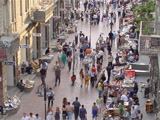|
|
TODAY.AZ / Society
Azerbaijani population to constitute 3.5% of post-Soviet populations by 2025
13 June 2006 [09:43] - TODAY.AZ

According to the report, prepared by the UN Department of Economic and Social Affairs human settlements division, 285 million people are living in the post-Soviet territory and they will reduce to 272 million by 2025. Russia shares half of the population of the post-Soviet arena but its weight in total number of population is reducing year after year. Russians constituted 56.7 percent of the USSR population in 1950. The figure reduced to 50.3% in 2005. This will reduce to 47.5% in 2025, according to the UN experts.
Ukraine's weight in the 'population basket' of the post-Soviet territory is also decreasing. 16.3% of the former USSR population is living in Ukraine now. It is forecasted that this figure will decrease 2.6% in 20 years.
Uzbekistan's population has increased to a great extent in the period between 1950 and 2005. Only 3.5% of the USSR population lived there in 1950 while it is 9.3% at present. According to the UN predictions, Uzbekistani population will constitute 12.5% of the post-Soviet population in 2025.
Kazakhstan (5.2%) and Belarus (3.4%) comes next for their weights in the 'population basket' in the post-soviet territory. According to the forecasts for 2025, Belarus's weight in the total number of population will reduce to 3.2%, and it will lag behind Azerbaijan which will reach its weight in the 'population basket' to 3.5%.
In general, the tempo of population increase was observed in Kyrgyzstan, Tajikistan, Turkmenistan, Uzbekistan and Azerbaijan in the post-Soviet territory in the second half of the 90s. The UN experts state the natural increase tempo of population is 1.5%-2% in Tajikistan, Turkmenistan and Uzbekistan. Despite natural increase of population in Kazakhstan and Armenia, speedy migration causes decrease of population in both countries, APA informs.
URL: http://www.today.az/news/society/27215.html
 Print version
Print version
Connect with us. Get latest news and updates.
See Also
- 08 August 2025 [12:00]
Azerbaijan explores cooperation opportunities with SpaceX - 08 August 2025 [10:31]
Baku hosts seminar on national contributions to transition towards green economy - 08 August 2025 [10:00]
Helicopter deployed to contain wildfire in Aghdara - 07 August 2025 [14:18]
Azerbaijani military joins Pakistan’s Independence Day and Victory parade - 07 August 2025 [12:37]
Azerbaijani Army participates in “Agile Spirit - 2025” exercises in Georgia - 07 August 2025 [11:19]
Final report on AZAL plane crash near Aktau expected in coming months - 06 August 2025 [15:30]
Russia targets Ukrainian compressor station supplying LNG and Azerbaijani gas - 06 August 2025 [14:13]
Price of Truth: tribute to Azerbaijan’s martyred media heroes - 06 August 2025 [13:28]
ADA University concludes first phase of AI and Innovation training in Ganja - 06 August 2025 [11:02]
Shahin Mustafayev to visit Iran for talks on joint border projects
Most Popular
 When peace comes: what the Armenian opposition fears and what awaits it
When peace comes: what the Armenian opposition fears and what awaits it
 Bilateral relations deepen as Azerbaijani and Georgian prime ministers meet in Turkmenbashi
Bilateral relations deepen as Azerbaijani and Georgian prime ministers meet in Turkmenbashi
 ExxonMobil to resume Libya operations after 10 years
ExxonMobil to resume Libya operations after 10 years
 Azerbaijan and United States begin new chapter in relations
Azerbaijan and United States begin new chapter in relations
 Azerbaijan's crude steel output falls 21.4% in first half of this year
Azerbaijan's crude steel output falls 21.4% in first half of this year
 President Ilham Aliyev sends congratulatory letter to Jamaican PM
President Ilham Aliyev sends congratulatory letter to Jamaican PM
 Kashmir’s longest siege: five years of silence, suffering, and struggle
Kashmir’s longest siege: five years of silence, suffering, and struggle
